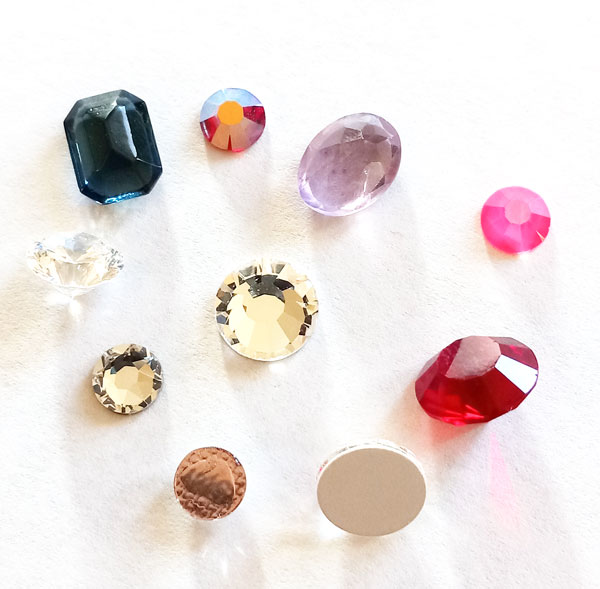|
Types of Rhinestones - Choosing the Best for Your Project Rhinestone items are in high demand. However, many of these goods are very expensive. Perhaps you’ve decided to try creating a bedazzled project. Yet, when you try to buy crystals, you find many different types of rhinestones. Should you buy the cheapest or most expensive and what’s the difference between them? What Is a Rhinestone? Before we talk about the different types of rhinestones, we need to look at a bit of history. Since ancient times, people gathered pretty rocks, fashioning talismans and later jewelry. One of the most abundant minerals on Earth also forms some of the prettiest stones. Depending on the elements that mix with quartz as it forms, the result is one of these gemstones:
Due to its characteristics of durability and variety of colors, jewelers prized quartz, especially clear quartz. One particular form of clear quartz mixed with lead during its formation, giving it glittering properties. Gem collectors found these rocks only in one particular place, along the banks of the Rhine River. Sadly, these natural rhinestones became depleted. Interest in manufacturing a replacement for natural rhinestones took root in the middle of the 1500s. Although bead glassmaking had been around since the height of the Roman Empire, enthusiasm for glassmaking had waned. However, during the 16th century, people began to desire beaded jewelry. With an abundance of natural resources, glassmaking became a major industry in Bohemia. Also during this time, jewelers were experimenting with gemstone cutting. Through cutting and polishing techniques, gem cutters labored to achieve the perfect display of color and visual effects. One particular gem cutter, Caspar Lehmann, was the first to adapt the tools and techniques of gem cutting to glass. Other artisans adopted these methods, paving the way for a patent on the world’s first cut crystal stone in 1715. Later on, artisans found ways to color the crystal glass. Additionally, they added a metal powder backing for greater light reflection. One Bohemian glassmaker patented an electric cutting machine to cut crystals faster and more precisely. This artisan moved to Austria and began his own company, Swarovski. Today, you’ll find many companies making rhinestones from 3 primary materials, plastic, glass, and crystal. What Are the Different Types of Rhinestones? Ultimately, the substance the manufacturer uses to create their product will determine the brilliance and shimmer of the embellishment. Generally, each material and manufacturing exhibits different clarity, dispersion, and refraction properties. Together, these characteristics create the sparkle and scintillation of the rhinestone. Another factor affecting the sparkle of the rhinestone is the number of facets. A facet is a small, polished, flat surface cut into the rhinestone to create light movement. The greater the number of facets, the greater the sparkle. Primarily, the manufacturer's choice of material will influence the arrangement and quantity of these surfaces. For example, crystal is denser than glass allowing manufacturers to cut more facets. Often, the scope of your bling project will help you decide which is the best type of rhinestone: 1. Plastic Using synthetic or naturally occurring materials, manufacturers form different types of plastics. Some of these plastics are suitable for rhinestones:
Manufacturers will either inject or compress the material of choice into their molds. Usually, these are the least expensive rhinestones, producing the lowest amount of sparkle. 2. Glass A higher quality of rhinestones is glass. The manufacturer may either cut or mold this type of rhinestone. Glass rhinestones produce a brilliant appearance and more sparkle than plastic rhinestones. Plus, they’re a cost-effective alternative to crystal. 3. Crystal Generally, manufacturers add lead oxide during glass production to form crystal. This new product is denser, stronger, and clearer than simple glass. With higher refractive and dispersion indices, crystal rhinestones produce the most sparkle. However, many rhinestone manufacturers have moved away from using lead due to health concerns. Today, brand-name rhinestone producers use barium, zinc, or potassium oxide instead of lead. Choosing From Among the Types of Rhinestones Usually, within these 3 classifications, you’ll find many different grades of each type. Manufacturers use different processes for production resulting in varying grades. So, within the crystal category, you can find rhinestones with 10, 12, or 15 facets. Furthermore, the availability of rhinestone sizes or colors varies between manufacturers. All of these factors can influence which is the best rhinestone for your project. Certainly, sometimes only the very best will do. For those times, we recommend the Preciosa Maxima brand. With over 500 years of tradition, this brand offers unbeatable sparkle in 100 colors. Moreover, Rhinestones Etc. has an extensive inventory of these rhinestones in stock and ready to ship. Since 2011, we have been providing customers with outstanding customer service and competitive pricing. Browse ouronline store and if you have any questions, send us a message.
0 Comments
Your comment will be posted after it is approved.
Leave a Reply. |
KarenI have been adding bling for over 20 years. Through my projects, I hope you find inspiration. Categories
All
Archives
July 2024
|
Home About Policies Return Shipping
Contact Us Size Chart Privacy Products Reviews
Copyright 2024 Rhinestones Etc. All rights reserved.
Contact Us Size Chart Privacy Products Reviews
Copyright 2024 Rhinestones Etc. All rights reserved.


 RSS Feed
RSS Feed